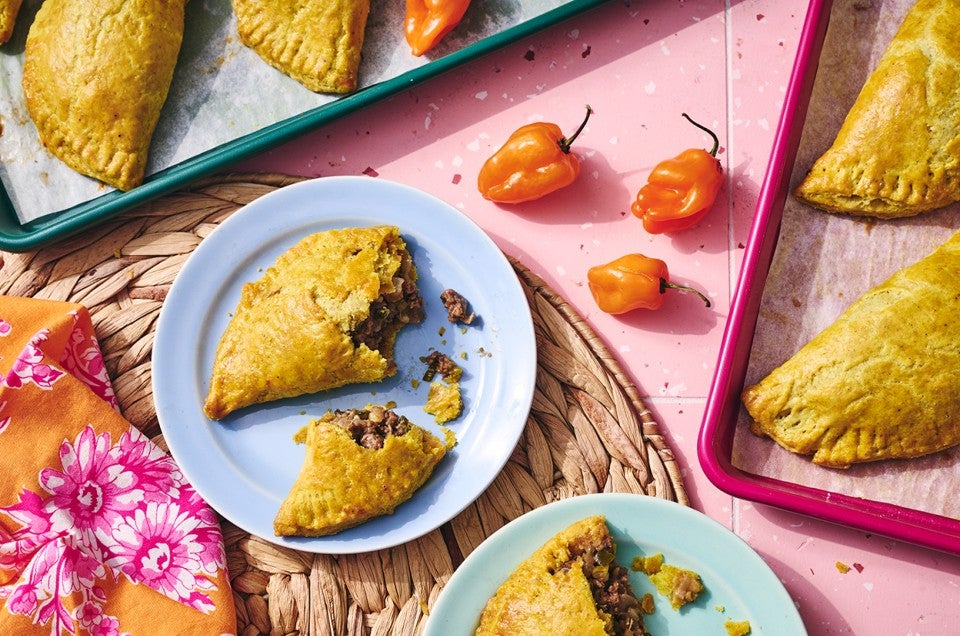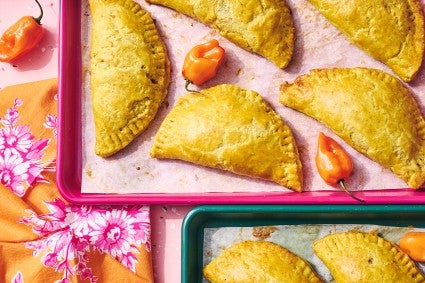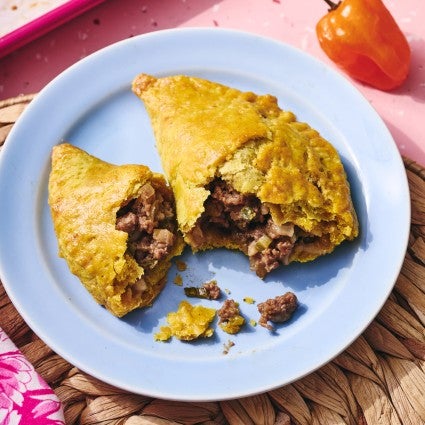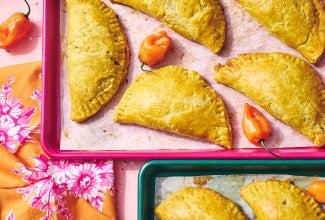A flaky hand pie offers bountiful lessons on identity and culture
For my kids, Jamaican beef patties are a key to their Caribbean heritage.


For my two children, Jamaican beef patties provide the answers to questions they haven’t yet asked.
In our home in Raleigh, North Carolina, the lunchbox is that nine-by-eight inch, lightly insulated turf where my children — Luke, 10 and Noelle, 8 — gently learn about themselves. As a Trinidadian cookbook author, married to a Jamaican physicist, we pack lunches that allow them to feel nourished, nurtured, and, when possible, connected to their Caribbean heritage; a smattering of foods that fills their bellies, as their minds expand alongside their understanding of the world — and their place in it. The standout favorites allow for both predictability and preference to live as equals: fresh fruit (ripe mangoes, skin-on quartered oranges), a hard-boiled egg or a narrow log of string mozzarella, something sweet (a pair of fig-filled bars and animal-shaped gummies — bears, worms, and bunnies, but never sharks).
The mains, however, tend to be trickier. “Mummy, peanut butter and jelly. But only strawberry jelly, not grape. And no peanut butter. And only on Hawaiian rolls. Ok? Ok!” Noelle insists. Luke’s requests are more brazen, bordering on the absurd. “Are you going to put a Shake Shack burger in my lunchbox today?” he asks with the easy confidence of a child for whom the words “time” and “reality” are abstractions, at best.
There is, however, one main they neither amend nor refuse: Jamaican beef patties. Every time we visit either one of our home countries, my husband and I tell our “Trin-Ja-Merican” kids that when it comes to the food, “Eat what is in front of you; there are no changes or substitutions.” And they surprisingly comply: drinking straight-from-the-nut coconut water, inhaling heaps of salt fish and coco bread, and devouring their collective body weight in jerk chicken and festival dumplings. Their ferocious appetite for all the foods they would likely frown upon if presented in another context is a parenting victory that my husband and I savor.

But ultimately, there is only one food that the kids request outside of Jamaica, and that is beef patties. The deeply flavorful hand-held meat pies have long been a street food and fast-casual staple on the island. The stewed ground beef — spiked with robust aromatics including allspice, ginger, and garlic — is encased in a crust scented with bright, nuanced spices, including curry powder and turmeric. And although there are several freezer-aisle riffs on Jamaican beef patties, the kids — and my husband, too — only want the real thing: scratch-made patties, where the aroma of stewed meat and the tender comfort of a freshly baked hand pie soothes, supports, and fills us in more ways than one.
When I make beef patties during the cold maw of winter — when the Caribbean feels acutely distant — it is a corrective grace. I feel my children’s little eyes on me as I add grassy fresh scallions and earthy thyme to the simmering meat. But most importantly, the kids ask questions about the recipe and inadvertently their own heritage, too. “What makes the dough so yellow?” Noelle inquires. I tell her about turmeric, how the vibrant gold spice is an anchor ingredient in South Asia, loved for its earthy flavor and healing properties. I also add that turmeric was brought to the islands when indentured servants from India worked on sugar cane plantations in the Caribbean after slavery. “I didn’t know that,” Luke says, in an octave significantly quieter than his usual voice. His roving eyes rest on mine, and I hold his gaze long enough to etch this moment in his forever memory.

I roll out the golden yellow dough, and once again the kids are rapt. “I love that just a little bit of turmeric makes the dough the color of the sun.” A tangible lesson in the nuance of quantity that I didn’t directly teach. The palpable fragrance of all the spices triggers their memory like a reflex. “It smells like Jamaica, mummy,” Luke notes.
Both of them continue to intently watch me spoon the meat mixture into the dough. I don’t know exactly what they are thinking, but behind their smiles and slightly furrowed eyebrows, I see the shape of their thoughts trace new revelations of a dark past, a resilient people, and their own story-of-origin. A silent beat passes between us. It’s a hush we all interpret differently. I want to tell them more about how Caribbean foods embody stories of faith, family, slavery, and survival, but I refrain.
“I can’t wait to take these to school tomorrow,” Luke says. To which Noelle agrees, “I’ll tell my friends, it’s Jamaican, so it’s part of me.” There it is, the answer to the question I didn’t ask, but beef patties delivered.
Cover photo and food styling by Liz Neily.


